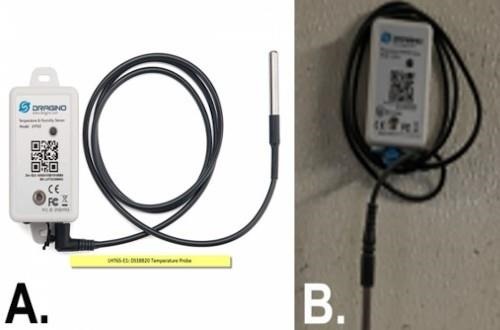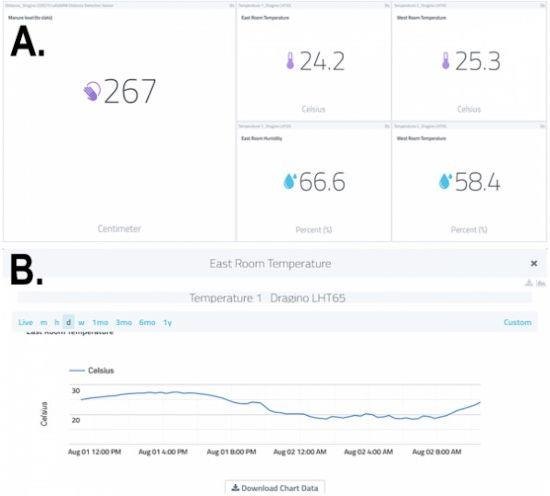By Xufei Yang
An appropriate thermal environment (temperature and humidity) is critical for animal growth and health. During very hot days, animals may suffer from heat stress, causing the loss of appetite, poor growth performance and increased mortality and morbidity; whereas cold temperatures may result in increased feed intake, a reduced growth rate and a decreased feed-to-meat conversion efficiency. In confinement barns, the thermal environment is regulated primarily by ventilation. However, undesired thermal environmental conditions could still happen, requiring timely human intervention. A similar challenge is faced by outdoor animal production systems as well.
Here, we present a low-cost solution to remote monitoring of the animals’ thermal environments using LoRaWAN Internet-of-Things (IoT) technology. It allows producers to access the real-time thermal environmental information on their cell phones, tablets or computers, and respond accordingly. It is noteworthy that the solution is for farms whose ventilation controllers can’t do remote monitoring. Modern smart controllers (e.g., Maximus brands) can do both remote monitoring and control, but they are expensive.
What do you need?
- LoRaWAN IoT temperature/humidity sensor.
A sensor measures air temperature and humidity and transmits the measurement data to an IoT gateway. Numerous low-cost (<$100 per unit) sensors are commercially available. Most of them are battery-powered and can work for years without battery replacement. - LoRaWAN IoT gateway.
A gateway gathers the data from multiple sensors and transfers them to the internet. A commercial LoRaWAN gateway costs several hundred dollars per unit, but it often can handle >100 sensors concurrently, so you can later add more sensors (e.g., manure level and soil moisture sensors) to expand your farm monitoring network.
- Network server (free!).
A network server manages the data flow on the internet. Nearly all LoRaWAN IoT projects use an open-source network server called The Things Network (TTN). TTN is free to the public but requires certain setup. - Application server (with cost-free options!).
An application server stores the measurement data and offers a user interface/dashboard to interact with producers. Numerous options are available, including paid (e.g., Amazon IoT) or free servers. You may decide based on system function, cost and cybersecurity considerations.
Example at the SDSU Research Farm
We set up a LoRaWAN monitoring system at the SDSU Swine Education & Research Facility (SERF) offsite farm. The farm has two mechanically-ventilated wean-to-finish rooms, with approximately 1,200 pigs total in the barn. The total cost of the system is $215.

Figure 1. A) A close look at the Dragino LHT65 LoRaWAN T/RH Sensor. B) A sensor mounted on the wall. Note: The sensor may better be tied to a water or feed line at the center of each room.
- A Dragino LHT65 LoRaWAN T/RH Sensor was selected ($33 per unit, including a battery). The sensor came with a temperature/humidity probe inside the sensor enclosure and a temperature probe on an extension cable (Figure 1-A). Two sensors were installed, with one in each room (Figure 1-B). The sensors are water-proof and can be tied to water or feed lines.
- A RAK7258 LoRaWAN indoor gateway ($149 per unit) was installed in the mechanical room of the barn. It connects to the internet via Wi-Fi that is available in the barn office.
- The Things Network (TTN) was used as the network server.
- A dashboard (Figure 2-A) was created using MyDevices Cayenne, a free, open-source application server. With the dashboard, a producer can not only browse the current temperature and humidity readings, but also access and download historical data records (Figure 2-B). Another useful function is ALERT/TRIGGER. For example, a text message can be sent to the producer when the temperature is higher or lower than certain thresholds.
Why LoRaWAN?

Figure 2. A) Example dashboard created with myDevices Cayenne. The system at the offsite hog farm also measures the manure level in the deep pit. B) Retrieving of historical temperature readings from the stored data.
LoRaWAN is a long-range wireless network technology and has a transmission range up to tens of miles. Comparatively, Wi-Fi and Bluetooth – two most commonly used wireless technologies – have a limited transmission range (typically ≤ 100 feet). The long-range wireless transmission is desired, if not required, for most farm network applications. An immediate benefit of LoRaWAN is that you can use one or a few gateways to cover a relatively large farm land or facility. The gateways can be installed in your farm office or house miles away from production areas. Unlike family or enterprise internet service, LoRaWAN is subscription free. Thus, LoRaWAN is more affordable than Wi-Fi or wired Ethernet in terms of initial and operating costs. Another benefit of LoRaWAN is its low power consumption. This enables LoRaWAN sensors to run on batteries for years without battery replacement, thereby simplifying the network setup and maintenance. Comparatively, Wi-Fi, Bluetooth and cellular networks must be wired to grids or use solar panels.
How can we help?
The setup of LoRaWAN monitoring systems is not difficult, but it involves many technical details. For the example project, the system was set up by two undergraduate students, with moderate aids from mentors. We are developing guidance documents for producers with little relevant background.
Source : sdstate.edu